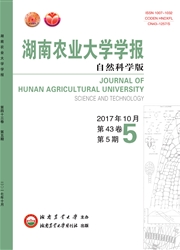

 中文摘要:
中文摘要:
以中籼超级稻两优293为材料,研究了3种氮肥施用模式(实地养分管理模式:施氮量120kg/hm2;实时养分管理模式:施氮量120和210kg/hm2;农民模式:施氮量210kg/hm2)下,水稻群体产量、辐射利用率及纹枯病病情指数的差异.结果表明,相同施氮量水平下,采用实地养分管理模式对中籼超级稻产量的提高效果好于实时模式,提高了辐射利用率,在施氮量120kg/hm2水平下,产量增加主要是因为群体的有效穗数、中后期群体叶面积指数、干物质积累总量的显著增加及辐射利用率的提高和群体纹枯病发病率的降低,产量、有效穗、干物质总量和辐射利用率与实时养分管理模式相比,分别提高1.61%、10.3%、13.3%和12.0%,纹枯病病情指数下降17.2%.
 英文摘要:
英文摘要:
The middle-season indica super-hybrid recombination Liangyou293 was used to study the performance of grain yield and radiation use efficiency(RUE) under three treatments of nitrogen management patterns.Site-specific nutrient management applied nitrogen 120 kg/hm2;Real-time nutrient management applied nitrogen 120 and 210 kg/hm2,and farm fertilizer practice applied nitrogen 210 kg/hm2.The result showed that,with the same amount of nitrogen fertilizer,the performance of grain yield increased and RUE improved.The site-specific nutrient management pattern was better than any other other patterns.The total number of effective panicles,leaf area index in the middle and late growth stage,and the accumulation of total dry matter significantly increased and the disease index of sheath blight also decreased,which suggested that these might be the main causes for the increase of grain yield and RUE under site-specific nutrient management pattern.Compared with real-time nutrient management,the grain yield,total number of effective panicles,dry matter and radiation use efficiency of site-specific nutrient management increased by 1.61%,10.3%,13.3% and 12.0% respectively,and that of ShBI decreased by 17.2% with the same applied nitrogen 120 kg/hm2.
 同期刊论文项目
同期刊论文项目
 同项目期刊论文
同项目期刊论文
 Yield Gap Analysis between Dry and Wet Season Rice Crop Grown under High-Yielding Management Conditi
Yield Gap Analysis between Dry and Wet Season Rice Crop Grown under High-Yielding Management Conditi Yield potential and radiation use efficiency of “super” hybrid rice grown under subtropical conditio
Yield potential and radiation use efficiency of “super” hybrid rice grown under subtropical conditio Rice varietal difference in sheath blight development and its association with yield loss at differe
Rice varietal difference in sheath blight development and its association with yield loss at differe 期刊信息
期刊信息
